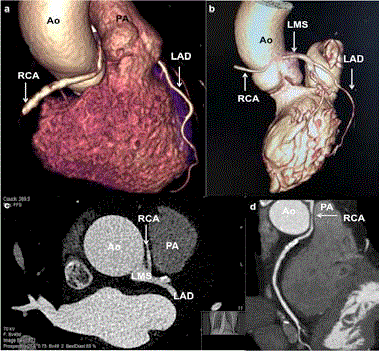Clinical Image
Anomalous Origin of the Right Coronary Artery from the Left Coronary Sinus with “Malignant Course”
Athanasios Antoniou* and Rizwan Attia
Department of Cardiac Surgery, Barts Heart Centre, St Bartholomew’s Hospital, London, UK
*Corresponding author: Athanasios Antoniou, Department of Cardiothoracic Surgery, Barts Heart Centre, St Bartholomew’s Hospital, West Smithfield, EC1A 7BE, London, UK
Published: 10 Aug, 2018
Cite this article as: Antoniou A, Attia R. Anomalous Origin
of the Right Coronary Artery from the
Left Coronary Sinus with “Malignant
Course”. Clin Surg. 2018; 3: 2065.
Clinical Image
An 81 - year - old lady presented to our hospital with an episode of chest pain during exercise lasting less than 30 mints, radiating to the neck and the left arm. There were no ischaemic changes on electrocardiogram or raised troponin levels. Her past medical history was otherwise remarkable for hypertension and hypercholesterolemia. She underwent angiogram which demonstrated an unobstructed Left Main Stem (LMS) with mild proximal atheroma in the Left Anterior Descending artery (LAD) and the Left Circumflex artery (LCx). There was an anomalous origin of the Right Coronary Artery (RCA) originating from the LMS before bifurcating into LAD and LCx (Figure 1). The angiogram also showed a proximal eccentric mild to moderate stenosis of the RCA which could represent either a plaque or a spontaneous dissection (Figure 1A). Following the above findings, a coronary computer tomography was performed (Figure 2). This revealed that there was no evidence of dissection of the RCA. The “malignant course“ of the RCA was seen as it originated from the LMS, travelled between the aorta and the pulmonary artery (Figure 2A-2D) with reduced calibre of its proximal segment (Figure 2D). Additionally, a stress perfusion cardiac magnetic resonance scan ruled out any inducible ischaemia in RCA territory. Taking into account the above findings, the age of the patient and the first presentation of ischaemia, medical management with Aspirin, betablockers, statins and risk factor modification was advised. If the symptoms worsen interventional management would be considered.


